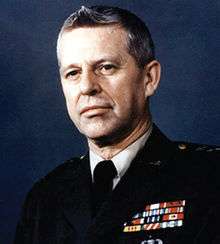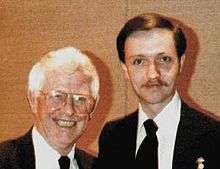Daniel O. Graham
| Daniel O. Graham | |
|---|---|
 | |
| Born |
April 13, 1925 Portland, Oregon |
| Died |
December 31, 1995 (aged 70) Arlington, Virginia |
| Place of burial | Arlington National Cemetery |
| Allegiance |
|
| Service/branch |
|
| Rank |
|
| Commands held |
Deputy Director, Central Intelligence Agency Director, Defense Intelligence Agency |
| Other work | Strategic Defense Initiative, NASA, DC-X |
Daniel O. Graham (April 13, 1925 – December 31, 1995) was a U.S. Army officer. Graham was born in Portland, Oregon and grew up in Medford. He attended college at the United States Military Academy at West Point, the army's Command and General Staff College, and graduated in 1946. He also attended the U.S. Army War College and ultimately rose to the rank of lieutenant general in the United States Army. Graham served in Germany, Korea, and Vietnam and received several decorations including some of the highest the United States military bestows: the Distinguished Service Medal, the Legion of Merit with two oak leaf clusters, and the Distinguished Intelligence Medal during his distinguished 30-year military career.
History
From 1963-1966, Graham worked for the CIA in the Office of National Estimates. During the Vietnam war from 1967-1968 he was chief of the army's military intelligence estimates.[1]
Graham served again in the Office of National Estimates during 1968-1971, then served as director of collections for the Defense Intelligence Agency in 1971. During 1973-1974 Graham served as deputy director of the CIA under Director William Colby and from 1974-1976 he was the director of the DIA. Ronald Reagan called upon General Graham to be his military advisor for his 1976 and 1980 campaigns. General Graham is a member of the Military Intelligence Hall of Fame.
In later years, Graham devoted a lot of time to the research and development of Single-Stage To Orbit (SSTO) spacecraft in conjunction with NASA. McDonnell Douglas was awarded a contract to build an SSTO test vehicle on August 16, 1991, and named it the DC-X for Delta Clipper Experimental. The name honored the firm's successful Thor/Delta rocket and recalled the famous 19th-century commercial clipper ships. The McDonnell Douglas SSTO team saw the Delta Clipper as opening the "space trade routes in the same way that the Yankee Clipper ships opened the sea trade routes." The needs of the commercial launch industry thus were integral to the thinking of the McDonnell Douglas DC-X team. General Graham envisioned the DC-X as the perfect inexpensive launch and delivery vehicle for his proposed Brilliant Pebbles space-based ballistic missile defense shield.[2]
The first test launch of the DC-X was on August 18, 1993. The test flight verified flight control systems and vertical landing capabilities and was deemed a success after reaching a 46 m altitude in a 59-second flight. The second flight on 1993 September 11, 1993 tested ascent and landing mode control and ground effects survey, reaching 92 m in a 66-second flight. The third test flight on September 30, 1993 demonstrated 180 degree roll and provided aerostability data while reaching 370 m during 57 second flight. Unfortunately, this marked the last test of first series as the vehicle was mothballed when SDIO funding ran out.
On June 20, 1994, the DC-X rose once again for the first flight of second series after additional SDIO funding was received. Operating with a full propellent load, the flight tested the radar altimeter in control loop and reached an altitude of 870 m during a 136-second flight. Demonstrating an unplanned event on June 27, 1994, the DC-X became the first unmanned vehicle to save itself when an in-flight abort occurred after a gaseous hydrogen explosion. The vehicle demonstrated autoland its capabilities after reaching an altitude of 790 meters during a 78-second flight. After repairs were made, the DC-X continued expansion of the flight envelope on May 16, 1995, demonstrating constant angle of attack after reaching an altitude of 1330 m during a 124-second flight.[3] Graham was elated and continued to work closely with the program. Graham would not live to see the full glory of the DC-X program. He died in December 1995.
On Friday, June 7, 1996 at White Sands, New Mexico, the second series vehicle designated DC-XA was successfully launched. It flew to a height of 485 meters (1,600 ft) and then moved horizontally 105 meters (350 ft) before safely landing. After that flight, NASA officials announced that the DC-XA had been renamed the "Clipper Graham." The next day, June 8, 1996, to demonstrate the quick-turnaround capability of the rocket, the Clipper Graham soared into the skies over the old White Sands Missile Range to a height of 3,120 meters (10,300 ft) and stayed in the air for over two minutes before landing. That flight was the highest and longest the vehicle had ever flown until then.[4]
Robert A. Heinlein dedicated his 1985 novel The Cat Who Walks Through Walls to Graham and eight of the other members of the Citizens' Advisory Council on National Space Policy.[5][6]
Political activism
Graham was chairman of the American Space Frontier Committee, the Coalition for the Strategic Defense Initiative, and in 1978 he became co-chairman of the Coalition for Peace through Strength.
After retiring from the army, Graham's goal was to promote a defense against nuclear weapons. The father of seven, said he felt it was unconscionable to fail to protect the American public against nuclear attack. Also, as a student of military history, he was keenly aware that no weapon was abandoned until a defense made the weapon obsolete.[7]
In 1981 Graham founded High Frontier, Inc., a private organization that promotes a kinetic-energy weapons approach to space-based defense with help from members of President Ronald Reagan's "Kitchen Cabinet".[8] According to Graham, he is considered by most to be the actual originator of the Strategic Defense Initiative concept.[9] However, the plan as put forward by Reagan also included an emphasis on directed energy technologies such as lasers and particle beams, in addition to the cheaper, "off the shelf" kinetic energy technologies promoted by Graham and High Frontier.
The Strategic Defense Initiative Organization was renamed by President Bill Clinton to the Ballistic Missile Defense Organization on May 13, 1993 and continues today.[10]

He was also a member of the American Freedom Coalition and was vice chairman of the U.S. Council for World Freedom, and served on the advisory board of a Unification Church sponsored anticommunist association, CAUSA- USA.[11]
Quote From Ronald Reagan
"As you know, Dan, you and I were talking about missile defense before you set up High Frontier in September of '81...You and a small group of dedicated, determined people helped us move the SDI concept over all the roadblocks put up by people of less vision and belief in American capacity. God bless you!"—President Ronald Reagan, March 1993[12]
Death
He died of prostate cancer at his home in Arlington, Virginia on Sunday, December 31, 1995 at the age of 70 and was buried at Arlington National Cemetery with full military honors.[13]
Footnotes
- ↑ Episode 3 — Central Intelligence Agency
- ↑ Fact Sheet #1
- ↑ DC-X
- ↑ SpaceViews Update: Top Stories
- ↑ Heinlein, Robert A (1986). The Cat Who Walks Through Walls. New England Library. ISBN 0-450-39315-1.
- ↑ Heinlein’s Dedications Page Jane Davitt & Tim Morgan Accessed August 20 2008
- ↑ Interview w/ Gen. Graham and family
- ↑ NASM Talk
- ↑ http://www.danielgraham.net/content/Chapter14.htm
- ↑ Bush and NMD - permanent.com
- ↑ The Washington Post. March 10, 1999 http://www.washingtonpost.com/wp-srv/national/longterm/cult/unification/image.htm. Retrieved April 30, 2010. Missing or empty
|title=(help) - ↑ HF Reagan Letters
- ↑ Daniel O. Graham, Lieutenant General, United States Army
References
- Confessions of a Cold Warrior - his autobiography, 1995
- Remembering General Dan Graham, by Paul Weyrich, cited by Hon. Frank R. Wolf in the House of Representatives, January 5, 1996
| Government offices | ||
|---|---|---|
| Preceded by Vincent P. De Poix |
Director of the Defense Intelligence Agency 1974–1975 |
Succeeded by Samuel V. Wilson |
